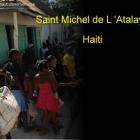ADVERTISEMENT
jacmel - Haiti Observer Blog
jacmel, Haiti Observer Blog. Read the following articles about jacmel
Venezuela and its link to Jacmel
There is a close relationship between Venezuela and Haiti and it has to do with the Creation of the Venezuelan flag. The city of Jacmel in Haiti has a leading role in this.
The original design of the flag was first flown on March 12, 1806 in the bay of Jacmel, Haiti. This was the place where Francisco de Miranda actually created the first Venezuelan flag near Jacmel. He was in charge of flying what would later become the first flag of Venezuela.
Historic data revealed that as the expedition of Miranda prepared to make the final leg of its voyage to Venezuela.
Jacmel, a city of former wealthy coffee merchants
The City of Jacmel was originally founded 1698 and became a major coffee trading centre during the colonization period with some of its residents, wealthy coffee merchants, considered at the time to be some of the most influential people in the Colony.
One important event that will change the shape of this influential city of Jacmel was the fire of 1896. This fire reduced the entire city to almost nothing, with only a few buildings left standing. The city of Jacmel was rebuilt but this time with a structure that will prove itself over time. Many of the homes since the fire of 1896 were made with prefabricated cast-iron pillars and balconies which would withstand fire. These materials were designed and built in France and shipped to Haiti.
Ti-Mouillage Beach near Jacmel
Near the city of Jacmel and on your way to Marigot, there are miles of undeveloped coastlines. Located on the outside of town is the imposing Ti-Mouillage Beach. This beautiful coast line is located approximately 17 km from Jacmel.
While you are on the beach of Ti-Mouillage, you will find several attractions
After enjoying a great time at Ti-Mouillage, you can go to the Fort Oge which was part of twenty Forts constructed after Haiti independence as a defensive system in the event the the French decided to return to the island to impose once again slavery. Fort Oge got its name after Vincent Oge , a leading figure of the Haitian Revolution.
Chaloska, The story of Charles Oscar and Carnival
The story of Chaloska goes as follows, Chief Charles Oscar was a military commander in charge of the police in Jacmel. He was feared by many
The specific things that made him a distinct figure is that he was tall and strong, with big teeth.
His story became one that crosses several generations in Haiti and somehow stays with the time.
It came at a time of great instability in Haiti, politically and socially. President Vilbrun Guillaume Sam was forced to contend with a revolt against his government, led by Dr. Rosalvo Bobo. Unable to do so, he fled to the French embassy, where he received asylum. The mulatto rebels broke into the embassy and captured him. The Haitian president was beating to death and his cadaver ripped into pieces and paraded the parts through the capital's neighborhoods.
Haitian born neurologist, playwrighter, poet and novelist Jean Metellus
Jean Metellus is a Haitian born neurologist, a playwright, a poet and novelist. He was born in Jacmel, Haiti on April 30, 1937. He completed his education in Republic of Haiti and later became a teacher. He escaped Duvalier's dictatorship by fleeing to Paris in 1959. In Paris he studied medicine and linguistics and obtained specialization in neurology. Jean was a gifted poet by birth and wrote several poems. He sent his poems to ethnologist Michel Leiris who then advised him to send his poemes to Maurice Nadeau who as Les Lettres Nouvelles editor. Jean also sent his poems to Jean-Paul Sartre. Jean Metellus' poems were published by Maurice Nadeau in Les Lettres Nouvelles and by Jean-Paul Sarte in Les Temps Modernes. Both these publications were made in July 1969.
Jacmel Mardi Gras Smashes Stereotypes
Jacmel is a city unto itself. Lying on the coastal waters of the Caribbean Sea, its celebration of Carnival knows no parallel elsewhere in Haiti. The focus of Carnival in Jacmel is Mardi Gras, the day before Lent begins with Ash Wednesday. Christians on this feast day receive a smudge of ash in the form of a cross on their foreheads, signifying repentance.
While other cities across Haiti celebrate Carnival with crowds of jostling dancers in traditional garb, Jacmel turns these entrenched practices on its head, preferring to stage impromptu theatre pieces in random spots along its streets.
Jacmel Carnival Symbol of Haiti Self-Determination
When Carnival season begins in Haiti, the seaside city of Jacmel divides its celebration into two halves. In the daytime, some celebrants meander through the streets dressed up in colorful paper-mache outfits, while others cover their bodies in shiny, black paint and wield ropes as imitation whips. They are addressing Haiti's slave history and the subsequent slave revolt.
Another roving group, the Chaloska, move through the streets in blood-red and black costumes, their faces decorated with over-sized lurid, red lips and monster fangs. They symbolize the 1915 bloody assault carried out on jailed political dissidents by the local police chief.
Jacmel Reacted on Jean Marie Patrice Etienne's slaying and Jorry Maxy's Kidnapping
One thing in Haiti that seems to become successful in its decentralization is the new phenomenon of Kidnapping in Haiti. On Monday (11-19-12), several hundreds of thousands of people took to the streets in Jacmel to denounce the slaying of well known agronomist Jean Marie Patrice Etienne and the kidnapping of 3 years old, Jorry Maxy.
The population in Jacmel is saying enough is enough. This has become the latest flashpoint in Haiti related to kidnapping. It ignited anger, drawing a crowd of thousands on Monday in Jacmel.
The population took the opportunity to denounce authorities in the City for not providing a safe environment for the population in Jacmel. The cited recent increase in criminality and kidnapping occurring throughout the city. This was the second time in just a few weeks that the population in Jacmel rose up against kidnapping.
Tourism Development Plan of Jacmel, "Destination Jacmel"
The Haitian Minister of Tourism, Stéphanie Balmir Villedrouin, and the greater government council continue the efforts to rebrand the country as a leading tourist destination within the Caribbean and the wider Western Hemisphere. Past projects to achieve this end have included a push from the tourism minister for a Caribbean airline, and efforts to revitalize Île à Vache. Most recently they have turned their sights to the restoration and rebranding of Jacmel.
With its prominent history and the remnants of this still present in the 19th century buildings, some of which were badly damaged by the 2010 earthquake, the southern town, founded in 1698, has been informally considered as a World Heritage site. Its fame is tied to its historical involvement in the War of Knives, and in the creation of the flag of Venezuela.
Loan to upgrade Cap Lamandou Waterview Hotel in Jacmel
The Cap Lamandou Waterview Hotel is in need of upgrading. The Clinton Bush Haiti Fund is a nonprofit making organization that was formed after the 2010 earthquake. It was at a time when President Obama requested former presidents Clinton and Bush to organize fundraising for Haiti. It was formed to collect money from well wishers, and the money collected was to be used to reconstruct Haiti by increasing job opportunities and causing economic improvement. With these two opportunities being created Haiti is believed to improve gradually.
Clinton Bush Haiti fund is meeting its role by giving $2.59 million loans to improve four businesses and workforce development programs. The four businesses were Regis College, Cap Lamandou Waterview Hotel, CLYF Quincallerie and SOFIHDES. These will ensure that Haiti will gain stability in its economy.
Our objective is to share with you news and information about Haiti and the people of Haiti. Traditions, habits and the way we were or grew are alive in this site. We highly recommend that you Subscribe to our Newsletter and also share with us some of the things that are memorable and made us unique people.

 Saint Michel de L 'Atalaye
Saint Michel de L 'Atalaye  Newsletter
Newsletter  Haiti tech Summit
Haiti tech Summit  Life After Death
Life After Death  Haitian Thanksgiving
Haitian Thanksgiving